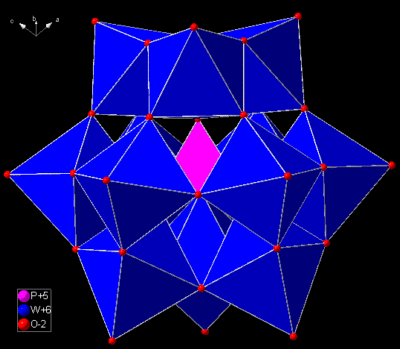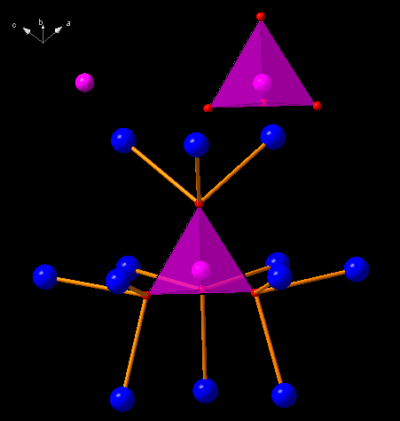Investigation of Coordination Spheres
|
Coordination spheres (whose sizes derive from bonding spheres) as well as
arbitrary spheres of fixed size can easily be checked by Diamond and used,
e.g. to create all or selected atoms within those spheres with or without
polyhedron faces.
The picture on the right demonstrates how the coordination spheres can be
checked and how the P-O-tetrahedra and distorted W-O-octahedra are linked
in the Keggin structure (Aquaoxoniumdodecatungstophosphate).
|

|
|
The second picture shows three steps of the creation of that scenery. First the
creation of a central P atom. Second the completion of the tetrahedral environment,
here symbolized by a transparent polyhedron. Third the generation of the W atoms
connected with the four O atoms of the central tetrahedron. The first picture is
then completed by generation of W-O-octahedra.
The following list of distances (in Angstroems) from P and W, rsp., to O is
taken from DIAMOND's tabular output of distances and/or angles. Together with
the histogram in the Connectivity dialog, you can use that output to control
the distances and angles within coordination or arbitrary spheres.
P 1 O 1 1.571
O 1 1.571
O 1 1.571
O 1 1.571
W 1 O 4 1.757
O 2 1.958
O 2 1.958
O 3 1.964
O 3 1.964
O 1 2.507
|

|
Reference:
ICSD Collection Code 908:
Name: Aquaoxonium dodecatungstophosphate
Formula: (H5O2)3PW12O40
Author(s): Brown G M, Noe-Spirlet M R, Busing W R, Levy H A
Title: Dodecatungstophosphoric acid hexahydrate, (H5O2)3PW12O40,
the true structure of Keggin's 'pentahydrate' from single crystal X-ray and neutron
diffraction data
Journal: ACBCA 33 (1977), pp. 1038 - 1046
|